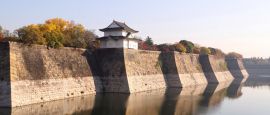Osaka History
Buddhism, battling warlords and booming industry have all played their part in Osaka’s story.
The city has been a gateway for international commerce and exchange since the fifth century, when it was known as Naniwa, and traded with China and Korea.
As well as bringing a wealth of goods and knowledge, Osaka’s foreign visitors introduced Buddhism to the town, and the religion rapidly spread across Japan.
In 645AD, Emperor Kotoku made Osaka his new capital, building Naniwa-no-Miya Palace, the oldest palace in the country. The capital moved to Asuka in 655AD and then later to Kyoto, but by then Osaka was flourishing, with new temples popping up and a thriving cultural scene.
For much of the 14th century, wars ravaged Osaka. But the Ishiyama Honganji Temple, built in 1496 and constructed as a fortress, served to keep the warlords at bay.
Nearly a century later, Toyotomi Hideyoshi succeeded in unifying Japan, constructing Osaka Castle in 1583 and making it his power base.
The entire town burnt to a cinder in 1615, but things calmed down after that and, though no longer the capital, Osaka began to prosper, sending rice and other foodstuffs to the rest of Japan.
The city became renowned as a hub for culture and education, and by the 19th century, it had transformed into a modern, industrial powerhouse.
During WWII, Osaka was almost decimated by Allied bombing, which explains the abundance of modern buildings and enormous skyscrapers dominating the city’s skyline today.
Post-war Osaka saw meticulous city planning and a return to prosperity. Osaka has become the economic centre of western Japan, attracting multinational companies.
Its rich cultural past is still evident in the local culture through the continued enjoyment of culinary pleasures, the performing arts and the city’s large entertainment areas.
Did you know?
• Around the end of the 19th century, Osaka was nicknamed the ‘Manchester of the Orient’, owing to its successful spinning industry.
• Osaka hosted Expo ’70, the first world exposition held in Asia.
• The first Universal Studios in Asia opened in Osaka in 2001.
Do you have any Feedback about this page?
© 2025 Columbus Travel Media Ltd. All rights reserved. No part of this site may be reproduced without our written permission, click here for information on Columbus Content Solutions.




 You know where
You know where